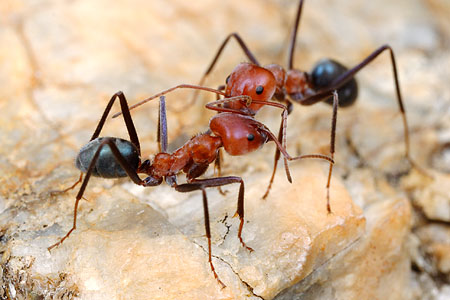
The blue-green iridescence on these Iridomyrmex purpureus workers shines from microscopic sculpturing on the ants' cuticle.
I've never taken to the Australian vernacular for one of their most conspicuous insects. The latin Iridomyrmex purpureus translates as "purple rainbow ant", referring both to the base color of the body and to the attractive metallic refractions on the cuticle. But Aussies instead call this colorful species the "meat ant." Crass by comparison.
On the other hand, it'd probably not do my reputation of masculine bravado much good were I to stroll into a dusty pub in the outback and announce my affection for "purple rainbow ants."Â Crikey! Meat ants it is, then.
A few more pics:

A young Iridomyrmex queen searches out a suitable place to begin a new colony.

Mature nests of Iridomyrmex purpureus are unmistakable.

A foraging worker pauses on a Eucalyptus blossom.

Iridomyrmex reburrus, a northern meat ant from Queensland
- Log in to post comments

This reminds me of a class presentation I once gave (30 years ago, yikes!) entitled "Invasion of the humble rainbow ant". It was about the Argentine ant, then included in the same genus as these iridescent Australian beauties -- and the "humble" part a translation of humilis, referring to their lack of iridescence.
BTW, I saw at least one other Linepithema in the field in lowland Ecuador, and specimens of various ants collected by you, Alex, in the collection at PUCE (university) in Quito a couple of weeks ago. The only live ants I saw in cool, foggy Quito were two individuals of L. humile and a single Monomorium -- more pitiful than the ant fauna in a coastal California city!
I have to say that I am agree that the "meat ant" common name is not the most flattering, but it took all its meaning to me when looking at the insect fauna on a dead emu on a side of a road, I realized that this one was covered by thousands of this ant.
Those running into the flesh and covering every single cm square of the dead beast really deserved their name at this point.
Those ants behave like a horde of furious Amazons.
In Western Australia, the rainbow ant to me was Rhytidoponera metallica! Such a beautiful ant.
Hey Alex
Just driven pass that nest its still going strong and with all this hot weather the ants are petty active.
LOL!! They would have probably kicked you out of that pub Alex!! You have captured its colors brilliantly though.